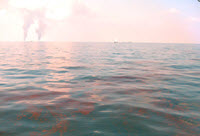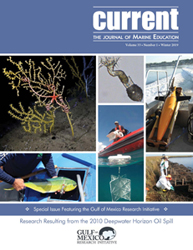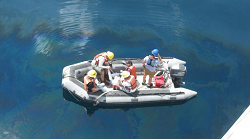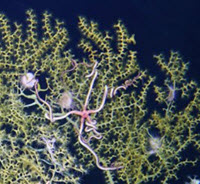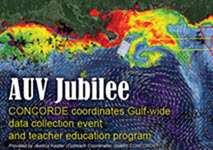Category Archives: ECOGIG
LBL Beacon Recovery Release Middle School Student Anja Diercks learns about acoustic release operation to recover a Long Base Line (LBL) acoustic beacon after a successful AUV dive. These LBL beacons are necessary in aiding the Inertial Navigation System of the AUV while on survey on the ocean floor, sometimes at depths of 1600 m Read More
Gary Finch Outdoors produced a series of videos highlighting various aspects of the Ecosystem Impacts of Oil and Gas Inputs to the Gulf (ECOGIG) program, its science, and the important partnerships necessary to make ECOGIG successful. Many of these videos were used by local PBS affiliates in Gulf coast states and were available through the Read More
The Ecosystem Impacts of Oil and Gas Inputs to the Gulf (ECOGIG) consortium worked with the Georgia Institute of Technology Center for Education Integrating Science, Mathematics, and Computing (CEISMC) to develop and test three middle school teaching modules. The modules developed are:– (7th Grade) Life Science – Data Visualization: “Under the Sea” Deep Sea Ecosystems Read More

This series of videos entitled “What’s That?” to explain the oceanography techniques that researchers use to collect data in the Gulf of Mexico. Videos in the series may be viewed in any order and include the videos below: Lamont Oceanographic Biochemical Observer (LOBO) Nitrogen and Carbon Fixation Methods Phosphorus and Nitrogen Filtration Methods Sampling the Read More
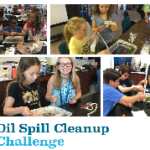
The Oil Spill Cleanup Challenge lesson plan and activity are designed to get students thinking about oil in the ocean, especially the 2010 Deepwater Horizon disaster and the challenge of oil spill response. The activity is appropriate for a wide range of ages and uses a water-filled tray to represent the Gulf of Mexico and Read More

There is now a novel way to reach audiences and help spark their interest in ocean science that involves the very popular world of video gaming. Launched by E-Line Media in conjunction with the BBC and researchers involved with their Blue Planet II series, the single-player narrative adventure Beyond Blue takes players deep into our Read More
These videos were developed to demonstrate research aboard the E/V Nautilus. ECOGIG in 60 Seconds Dr. Katy Croff Bell, Chief Scientist of the EV Nautilus crew, explains the mission of ECOGIG. Imaging Deep-Water Corals (Nautilus Live) As part of the ECOGIG project, the E/V Nautilus made its way to the site of the 2010 BP Read More

A journey reveals that her voice matters. A trip changes his work motivation. The theme of disaster response frames both of these touching and inspiring science stories. Members of the Gulf of Mexico Research Initiative community, Samantha (Mandy) Joye and Simeon Pesch, joined scientists Jessica Moreman, Laura Guertin, and Paula Buchanan and shared their personal Read More

These small, educational brochures each highlight ten practical lifestyle practices that individuals can adopt to take better care of the world’s ocean. They can act as hand-outs for people visiting a table, educational booth, or public event. These files can be printed on card stock, cut, and folded into wallet-sized cards: Ten Ways You Can Read More

These learning activities introduce students to different deep-sea organisms living in the Gulf of Mexico. The Build a Deep-Sea Coral activity utilizes an easy craft project to get students thinking about the architecture of deep-sea corals (which is different from shallow-water corals) and the animals that live on or near the coral. Students can also Read More

The Adventures of Zack and Molly is a four-part animated short video series that tells the story of a young man, Zack, who is more interested in the small world of his smartphone than the larger world around him. Zack’s online request for a roommate is answered by Molly, a tech-savvy Dumbo Octopus on a Read More
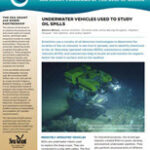
Have you ever wondered how scientists ‘see’ under water? The Gulf of Mexico Research Initiative is pleased to announce a new Sea Grant publication about the technology scientists use to look at and study the deep ocean, specifically manned and unmanned vehicles. Scientists have used remotely operated vehicles (ROVs), autonomous underwater vehicles (AUVs), and submarines, Read More
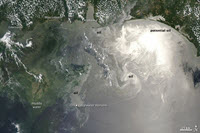
The Smithsonian’s Ocean Portal published an interactive tool featuring maps and graphics showing where Deepwater Horizon oil traveled. The story map also includes locations for where responders applied chemical dispersants on the Gulf’s surface and other sources where oil enters the Gulf, such as offshore oil and gas platforms and natural seeps. Try out the Read More
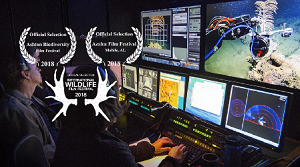
Jewels of the Gulf is a 16-minute documentary highlighting research into Deepwater Horizon’s continued impacts on deep-sea corals. Background: On April 20th 2010, approximately 50 miles from the Louisiana coastline, the Deepwater Horizon oil rig experienced a catastrophic failure that resulted in the largest marine oil spill in history. Over the course of 87 days, Read More
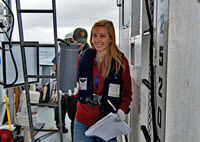
Responders to the Deepwater Horizon incident applied unprecedented amounts of chemical dispersant on the surface oil slick and into the deep underwater plume forming from the riser pipe. Shortly thereafter, researchers observed that a brown flocculant material containing oil and dispersant components covered some deep-sea corals near the incident site. Danielle DeLeo, during her graduate Read More
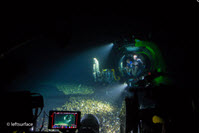
“Magical discovery moments” is how Dr. Samantha “Mandy” Joye describes scenes at the bottom of the ocean. Now, thanks to the BBC-produced documentary series Blue Planet II, we can get a glimpse of these discovery moments and join discussions about the ocean’s importance. The series, narrated by David Attenborough, includes seven episodes about exploring the Read More
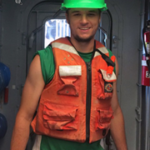
Natural seeps are abundant in the Gulf of Mexico and help create a chemically unique habitat where microbial populations can flourish. Andy Montgomery is researching the relationship between marine microbes and ocean chemistry and how chemical shifts affect the role microorganisms play in biogeochemical cycling, a common pathway for chemicals and organic matter to move Read More
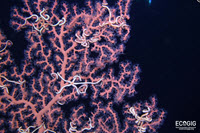
The Smithsonian’s Ocean Portal published an article about deep sea coral affected by the Deepwater Horizon incident and how their recovery is linked to the sea creature that lives on them. The ECOGIG research consortium are monitoring the health of these corals over time using high-resolution imagery, and they have made some amazing discoveries. Read Read More
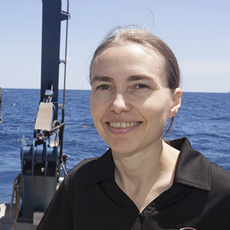
Dr. Mandy Joye recently appeared on the show to discuss her research on the ocean’s microbial “worker bees,” which carry out critical processes that keep the ocean healthy, and their reaction to the Deepwater Horizon oil spill.

Campers aged 11-14 explored ocean topics such as deep oceans, ecosystems, and chemosynthetic processes through hands-on projects, games, videos, and slideshows. The students also designed and built their own remotely operated vehicles (ROVs) and created stop-motion videos based on the camp’s themes. View the campers’ ROVs. Watch their stop-motion films. See photos from the camp. Read More
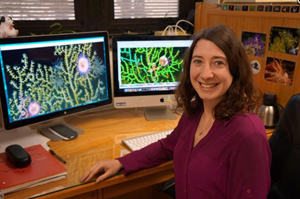
Deep-sea corals are important organisms that support a healthy and diverse deep-sea ecosystem. However, there is much we do not know about certain coral species, including how they grow, reproduce, or interact with other organisms. Fanny Girard’s research helps bridge that knowledge gap through her work on how disturbances such as oil spills affect deep-sea Read More
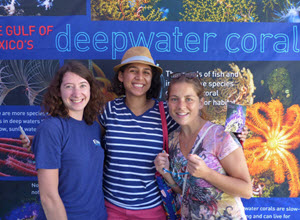
Scientists and education staff have tapped into a novel venue – football games – to reach new audiences and share ongoing research and ocean technology. The research consortium Ecosystem Impacts of Oil and Gas Inputs to the Gulf II (ECOGIG II), funded by the Gulf of Mexico Research Initiative (GoMRI), took their mobile Ocean Discovery Read More

Ecosystem Impacts of Oil and Gas Inputs to the Gulf (ECOGIG) Consortium outreach staff recently brought the Ocean Discovery Zone to Penn State’s Fan Fest for the season’s first home game. Visitors explored the Gulf’s deepwater ecosystems and learned about the importance of healthy oceans. View photos or watch a time-lapse video of the event to learn more. Read More

The Spring Boy Scouts Advance-A-Rama (AAR) program has been conducted for over 25 years by volunteers from the Northeast Georgia Council’s Cherokee District. The AAR is hosted by the Warnell School of Forestry and Natural Resources at the University of Georgia. In recent years, over 200 scouts from troops in Alabama, Georgia, South Carolina, and Read More
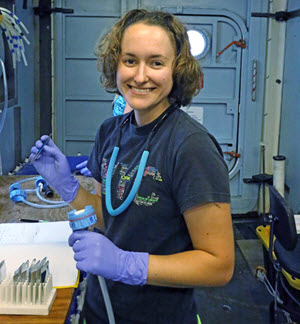
Kelsey Rogers looks for evidence of oil and methane intrusion into Gulf of Mexico water and sediment, but finding these hydrocarbons is only the beginning of her work. Like a scientific crime scene investigator, Kelsey analyzes the chemical fingerprints of oil and gas and uses them to identify their source, such as from an oil Read More

Dr. Jeff Chanton recently appeared on Minnesota Public Radio’s Climate Cast podcast to talk about the ongoing Aliso Canyon methane gas leak and why methane is so destructive. You can listen to the full interview here under the heading “Climate Cast; Methane leak causes state of emergency in California.” Link to ECOGIG’s website for more information.

A pod of dolphins (and a few sharks!) visited the R/V Endeavor during a research cruise in the Gulf of Mexico; they spent several hours hanging around the ship. Some of the researchers on board put a GoPro camera in the water to capture these beautiful animals swimming near the ship. Video processing by Emma Read More
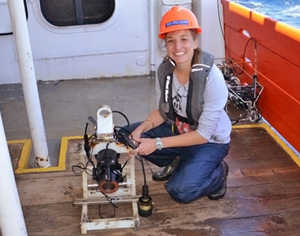
Caroline Johansen laughs when her family tells others that her research involves counting bubbles. But the bubbles she studies come from seeps at the bottom of the Gulf and contain naturally-occurring hydrocarbons that are an important part of the deep-sea ecosystem. Caroline wants to shed light on how much oil enters the water every day Read More
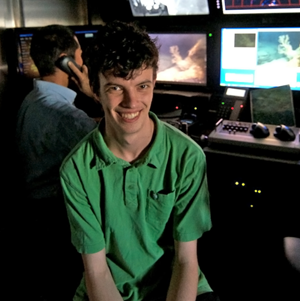
Deep below the surface of the Gulf of Mexico live vast canyons of coral. Recent news reports suggest that the Deepwater Horizon oil spill may have impacted the health of these corals. To find out, Richard Dannenberg is delving into their world, looking at the bacteria that live with the coral for clues about that Read More

